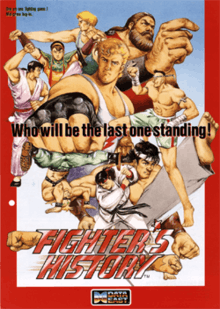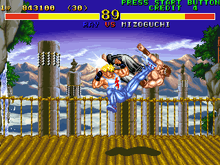Fighter's History (video game)
Fighter's History[lower-alpha 1] is a 1993 arcade fighting game developed and published by Data East. It's the inaugural game in the Fighter's History series. The main unique feature of the Fighter's History is its weak point system, which allows the player to temporarily stun an opponent by repeatedly hitting their weak point.
| Fighter's History | |
|---|---|
 European arcade flyer of Fighter's History, the first game in the series | |
| Developer(s) | Data East |
| Publisher(s) | Data East |
| Producer(s) | Hideo Fukuda Yukihiro Kawai Masato Noguchi |
| Composer(s) | Gamedelic |
| Series | Fighter's History |
| Platform(s) | Arcade, SNES |
| Release | Arcade
|
| Genre(s) | Fighting |
| Mode(s) | Up to 2 players |
| Cabinet | Upright |
| Arcade system | Data East ARM6 |
| Display | Horizontal |
Fighter's History is famous for having Data East caught in a lawsuit filed by Capcom, which claimed the game is too similar to its hit title, Street Fighter II, and as such is deemed copyright infringement on its property. The case tilted in Data East's favor, however, as the court found that the copied elements were scenes a faire. The game was later ported to the SNES in 1994, and followed by a sequel Karnov's Revenge for Neo Geo.
Gameplay

Fighter's History uses a six-button control configuration similar to Street Fighter II and its iterations, with three punch buttons and three kick buttons, each for different strength levels (light, medium, and heavy). There are a total of nine playable characters, as well as two non-playable boss characters at the end of the single-player tournament. The final boss and sponsor of the tournament is revealed to be Karnov, the protagonist of the Data East action game of the same name.
The main unique feature Fighter's History is its "weak point system". By repeatedly hitting an opponent's weak point, the player can temporarily stun them once per round, leaving the opponent open for an attack. The location of an opponent's weak spot varies with each character and is usually represented by a specific article of clothing (i.e.: a headband, a vest, a mask). After an opponent's weak point is exposed, hitting it will also cause the opponent to sustain greater damage when the weak point is repeatedly struck afterward.
Release
Fighter's History was first released for the arcades in 1993. The game was ported to the Super NES in Japan on May 27, 1994, and later published for North America on August of the same year. The two boss characters, Karnov and Clown, are both playable in the home version through the use of a code.
The SNES version later got a digital re-release for Windows-based online store Project EGG on July 19th, 2011 only in Japan. In 2017, the same version received a physical cartridge re-print by Retro Bit in part of a compilation Data East Classic Collection, which also includes the SNES-only sequel Fighter's History: Mizoguchi Kiki Ippatsu!!.[1]
Reception
| Reception | ||||||||
|---|---|---|---|---|---|---|---|---|
| ||||||||
In Japan, Game Machine listed Fighter's History on their May 1, 1993 issue as being the second most-successful table arcade unit of the year.[4]
Electronic Gaming Monthly gave the SNES version a 6.75 out of 10. They commented that the graphics are average, but highly praised the controls as exceptional for a fighting game.[2] Nintendo Power wasn't impressed with the SNES version, stating that the lack of originality fails to make Fighter's History stand out from other games, and criticized the poor sound.[3] GamePro gave the SNES version a negative review, calling the game "an unremarkable [Street Fighter] knock-off with solid but slow game play", and heavily criticizing the "bland" character design.[5]
Chris Shive of Hardcore Gamer called the SNES version as "[a] bootleg Street Fighter II" in his Data East Classic Collection review. The reviewer was umimpressed with the core gameplay that doesn't much differ from other contemporary fighting games, although he added that the game is quite fun nonetheless.[1]
Lawsuit
At the time of the game's release, Capcom U.S.A. sued Data East Corp. over Fighter's History due to what Capcom U.S.A. felt were infringements on its Street Fighter II property. Capcom also filed similar claims against Data East in Japan.[6] Data East Corp.'s largest objection in court was that their 1984 arcade game Karate Champ was the true originator of the competitive fighting game genre, which predated the original Street Fighter by three years.[7] Judge Orrick set an October 31, 1994 trial date, stating that he could not deny "the strong evidence that it set out to copy Street Fighter's success," noting similarities such as a "Chun-Li clone" (referring to Feilin) and several comparable special moves.[6] However, Capcom U.S.A. lost the case on grounds that the copied elements were scenes a faire and thus excluded from copyright.[8]
See also
References
- Chris Shive (January 1, 2018). "Review: Data East Classic Collection (SNES)". Hardcore Gamer. Retrieved December 22, 2018.
- "Review Crew: Fighter's History". Electronic Gaming Monthly (59). EGM Media, LLC. June 1994. p. 33.
- "Now Playing: Fighter's History". Nintendo Power (63). August 1994. p. 70.
- "Game Machine's Best Hit Games 25 - テーブル型TVゲーム機 (Table Videos)". Game Machine (in Japanese). No. 448. Amusement Press, Inc. 1 May 1993. p. 25.
- "ProReview: Fighter's History". GamePro (60). IDG. July 1994. p. 74.
- "Capcom, Data East in Fighter's Fight". GamePro (59). IDG. June 1994. p. 182.
- GAMEST Magazine. 134. December 30, 1994. Missing or empty
|title=(help) - Capcom U.S.A. Inc. v. Data East Corp. 1994 WL 1751482 (N.D. Cal. 1994). Analysis at Patent Arcade accessed June 18, 2009.